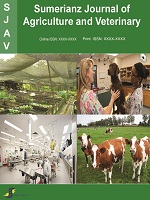Sumerianz Journal of Agriculture and Veterinary

Online ISSN: 2617-3077
Print ISSN: 2617-3131
Quarterly Published (4 Issues Per Year)
Journal Website: https://www.sumerianz.com/?ic=journal-home&journal=30Archive
Volume 5 Issue 3 (2022)
Challenges to the Use of Information and Communication Technology Tools for Rural Livestock Production in Imo State Nigeria
Authors : Ibe M. N. ; Chikaire J. U. ; Aminu G.
DOI : doi.org/10.47752/sjav.53.62.67
Abstract:The study examined the challenges faced by rural livestock farmers in the use of ICT tools. The specific objective included identifying IT tools used; livestock animals kept; information needs of rural livestock farmers examining challenges faced by the rural livestock farmers in the use of ICT tools and proffer solutions to the challenge. A total of 150 ICT user farmers were used to elicit information from respondents using a structured questionnaire. Data collected were analyzed descriptively. Result showed that the livestock farmers used radio (98.6%), mobile phones(96.6%), television(90%). They also keep poultry birds (98%), pigs (92.6%), and goats (87%). The farmers need information on animal disease/control (90.8%), market & prices (100%), housing techniques (94.2%) availability of loan/credits (97.5%), check availability (86.6%), prices of drugs (84.2%) among others. The challenges facing rural livestock farmers included high communication costs (585), lack of regular electric power supply(87.3%), language problems (80%), lack of computer skills (83.3%), inappropriate content (58.6%), and high level of illiteracy (86.6%) among others. To address the challenges, a regular power supply is provided, network connectivity is improved and training of farmers in ICT use among others.
Urtica Spp.: From Underutilized Crop Towards Sustainability
Authors : Baraa Munir Al-mansour
DOI : doi.org/10.47752/sjav.53.58.61
Abstract:Sustainability of agricultural systems has become an important issue throughout the world. The need to balance environmental quality, human needs and economic stability is often referred to as “the three pillars of sustainability”. Nettle is one of the most widely distributed wild plants, found in all regions of the temperate zones, growing in all seasons, and having ethnobotanical importance as a wild plant. Cultivation of this underutilized crop has potential to be valuable food, medicine source, organic fertilizer and carbon sink in addition to its economic advantages. It needs further expanded and assisted by agricultural extensions to be part of management strategies in tackling food and environment insecurity.
Influence of Variety and Poultry Manure Rates on Growth, Yield, Incidence and Severity of Fusarium Wilt Disease on Three Pepper (Capsicum annum) Varieties
Authors : Iwuagwu C. C. ; Agbodo M.I. ; Nwogbaga A. C. ; Aguwa U. O. ; Iheaturu D. E. ; Ejiofor M. E.
DOI : doi.org/10.47752/sjav.53.44.57
Abstract:A field experiment was conducted to study the effect of different rates of poultry manure on growth, yield, incidence and severity of fusarium wilt on three varieties of pepper (Capsicum annuum). The research was carried out at the Crop Science and Horticulture research farm of the Faculty of Agriculture, Nnamdi Azikiwe University Awka, Anambra State-06⁰15ˈ2ˈˈN,7⁰6ˈ59ˈˈand 51m above sea level. The experiment lasted from June to August 2019 wet season planting. The pepper varieties used include: California wonder (green), Efia red and Nsukka yellow. The three pepper varieties received 0tons/ha, 8tons/ha and 16tons/ha of poultry manure. It was a 3 x 3 factorial experiment laid out in a Randomized Complete Block Design (RCBD) and replicated thrice. Variety influenced (P<0.05) plant height where the Nsukka yellow pepper gave the tallest plants (46.60cm) while the shortest was the green variety (27.0cm) at 8WAT. Highest number of leaves were obtained in red variety (167.9) which was significantly different (P<0.05) from the other varieties. No significant difference was observed in the leaf area of the three varieties (P>0.05) at the second and fourth WAT though Nsukka yellow had the largest leaf area at 4WAT and, Efia red was largest at 6WAT. Poultry manure application influenced leaf area (P<0.05) at 2nd, 4th and 6WAT. Poultry manure at 16 tons/ha gave the largest leaf area at 2nd, 4th, 6th and 8WAT. There was a significant (P<0.05) varietal effect on incidence and severity of diseases where the green variety had the highest incidence and severity of wilt. Poultry manure also influenced incidence and severity of Fusarium wilt disease where highest incidence and severity was obtained at 0tons/ha. There was a significant interaction (P<0.05) effect of variety and poultry manure rates which was observed on plant height at 2nd,4th ,6th and 8WAT. Yellow x 8tons/ha gave the tallest plants at 8WAT. Effect poultry manure rates on the number of fruits, weight gain, fruit length, fruit diameter, number of locus and fruit girth were not significantly different (P>0.05), though the highest (5.70) number of fruits was obtained at 8ton/ha poultry manure application This was followed by 4.93 at 16ton/ha, while the least number of fruits was produced when 0ton/ha was applied Poultry manure at 8tons/ha also produced the highest pepper fruit weight with a mean value of (5.700g) though not statistically different from the other two varieties. It is therefore that farmers should adopt the application of 8tons/ha poultry manure, as this was most suitable in terms of yield and increase beyond this level may not lead to appreciable marginal increase in yield as observed in this investigation.


